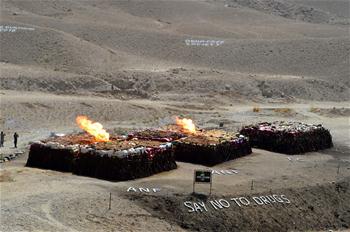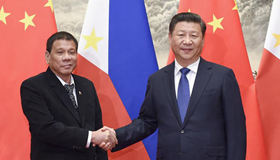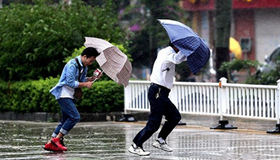BEIJING, Oct. 21 (Xinhua) -- A convention was held on Friday to commemorate the 80th anniversary of the victory of the Long March at the Great Hall of the People in downtown Beijing.
From October 1934 to October 1936, Red Army soldiers left their bases and marched through raging rivers, snowy mountains and arid grassland to break the siege of Kuomintang troops and continue to fight Japanese invaders. Some marched for 12,500 km.
"The Long March is the glory of the people's army, and the honorable people's army must always carry forward the great spirit and fine tradition of the Red Army in the Long March," Chinese President Xi Jinping told the commemorative gathering.
He summarized "the Long March spirit" as seeking truth from facts, strictly observing discipline, bearing in mind the overall interests, solidarity, and relying firmly on the masses and going through thick and thin together with them.
The Long March won praise from overseas scholars, journalists as well as late dignitaries.
"Compared to the Long March, Hannibal's crossing of the Alps looked like a holiday excursion beside it," noted American journalist Edgar Snow in his book "Red Star Over China" published in 1937.
"Adventure, exploration, discovery, human courage and cowardice, ecstasy and triumph, suffering, sacrifice, and loyalty, and then through it all, like a flame, an undimmed ardor and undying hope and amazing revolutionary optimism of those thousands of youths who would not admit defeat by man or nature of God or death -- all this and more seemed embodied in the history of an odyssey unequaled in modern times," wrote Snow.
For another American writer Harrison E. Salisbury, also a former New York Times correspondent, the Long March represented "a great human epic which tested the will, courage, and strength of the men and women of the Chinese Red Army."
"If anyone should think the journey was some kind of Potemkin trip through a gussied-up China, well, the route was more than twice as long as that between New York and San Francisco," Salisbury wrote in an article published in 1984, right before the publication of his book "The Long March: The Untold Story."
In an interview after he finished retracing the Long March, Salisbury said: "Only, I felt, by traveling those 7,400 miles could I write an accurate account of the Long March. Only so could I convey some small sense of the ordeal of the men and women who made the march."
After experiencing parts of the route of the Long March in 1981, former U.S. national security advisor Zbigniew Brzezinski wrote that "for the emerging new China, the Long March is more than an epic of almost unmatched heroism. It is the reminder of the spirit of national unity essential to overcome a legacy of backwardness."
Some foreign scholars said that the Chinese Long March is a "stately monument" in the history of the great rejuvenation of the Chinese nation, stressing that the significance of the remarkable event should resonate down the centuries, from generation to generation.
British missionary Rudolf Alfred Bosshardt, who had followed the Red Army's Long March in 1934, described in his book "The Restraining Hand" that "these people, known as bandits by the Kuomintang, are in fact people who believe in Marxism and practice its principles."
U.S. General Samuel B. Griffith remarked in his book named the Chinese People's Liberation Army: "From this trial emerged a group of tested leaders, supremely confident of their ability to shape the destiny of their party and their country. And from it, too, sprang an indoctrinated army endowed with a rich experience, convinced of the righteousness of its cause and equipped with a dynamic doctrine of guerrilla and mobile war."
Author of "The Long March 1935" Dick Wilson, who was then senior editorial adviser to a now defunct Singapore newspaper the New Nation, said "the Long March remains an unparalleled human story of sheer dogged grit and determination."
"The pure bravado of the collective and individual feats of this great army in 1934-35 must claim respect and admiration from every generation," Wilson praised.











